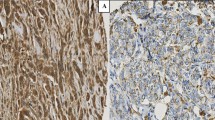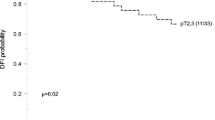Abstract
In order to address the heterogeneity of the pT1 breast cancer stages, we have been examining the natural and the clinical course of disease in relation to cathepsin D expression, as a molecular marker for the tumor progression that leads to metastasis. The original aim of our pilot study was to determine whether it was possible to distinguish high-risk from low-risk patients, on the basis of nonestrogen- vs. estrogen-regulated cathepsin D expression. Our results showed that estrogen-regulated cathepsin D expression could be useful as surrogate marker of node-positive status. Further, during the natural course of disease, none of 7 pT1N0 patients with tumors bearing nonestrogen-regulated cathepsin D expression developed metastasis. During the clinical course of disease, nonestrogen-regulated cathepsin D expression defined low-risk while estrogen-regulated cathepsin D expression defined high-risk pT1N+ subgroup of patients. Although there is no consensus with respect to metastasis-related prognostic value of cathepsin D expression, our pilot study implies its prognostic value in pT1 breast cancer patients and supports the hypothesis that cathepsin D may promote metastasis in this early stage of disease.
Similar content being viewed by others
References
Ries LAG, Eisner MP, Kosary CL et al. SEER Cancer Statistics Review. 1973–1998, 2001.
Breast cancer screening. In Vainio H and Biachini F (eds): IARC Handbooks of Cancer Prevention, Vol 7. Lion: IARC Press 2002; 25–46.
PR Rosen S Groshen PE Saigo et al. (1989) ArticleTitleLong-term follow-up study of survival in stage I (T1N0M0) and stage II (T1N1M0) breast carcinoma J Clin Oncol 7 355–66 Occurrence Handle2918331
KC Lee (1988) ArticleTitleThe clinical alert from the National Cancer Institute N Engl J Med 319 948–9 Occurrence Handle3419459
WL McGuire GM Clark (1992) ArticleTitlePrognostic factors and treatment decisions in axillary node-negative breast cancer N Engl J Med 326 1756–61 Occurrence Handle1594018
BA Leone A Romero MG Rabinovich et al. (1988) ArticleTitleStage IV breast cancer: clinical course and survival of patients with osseous versus extraosseous metastases at initial diagnosis. The GOCS (Grupo Oncologico Cooperativo del Sur) experience Am J Clin Oncol 11 618–22 Occurrence Handle3055932
MJ Duffy (1992) ArticleTitleThe role of proteolytic enzymes in cancer invasion and metastasis Clin Exp Metast 10 145–55 Occurrence Handle10.1007/BF00132746
N Bossard F Descotes AG Bremond et al. (2003) ArticleTitleKeeping data continuous when analyzing the prognostic impact of a tumor marker: an example with cathepsin D in breast cancer Breast Cancer Res Treat 82 47–59 Occurrence Handle10.1023/B:BREA.0000003919.75055.e8 Occurrence Handle14672403
SM Thorpe H Rochefort M Garcia et al. (1989) ArticleTitleAssociation between high concentrations of Mr 52,000 cathepsin D and poor prognosis in primary human breast cancer Cancer Res 49 6008–14 Occurrence Handle2790815
H Rochefort (1992) ArticleTitleBiological and clinical significance of cathepsin D in breast cancer Acta Oncol 31 125–30 Occurrence Handle1622626
PM Ravdin (1993) ArticleTitleEvaluation of cathepsin D as a prognostic factor in breast cancer Breast Cancer Res Treat 24 219–26 Occurrence Handle10.1007/BF01833262 Occurrence Handle8435477
JA Foekens MP Look J Bolt-de Vries et al. (1999) ArticleTitleCathepsin D in primary breast cancer: Prognostic evaluation involving 2810 patients Br J Cancer 79 300–7 Occurrence Handle10.1038/sj.bjc.6690142 Occurrence Handle9888472
AM Billgren LE Rutqvist H Johansson et al. (2000) ArticleTitleThe role of cathepsin D and PAI-1 in primary invasive breast cancer as prognosticators and predictors of treatment benefit with adjuvant tamoxifen Eur J Cancer 36 1374–80 Occurrence Handle10.1016/S0959-8049(00)00114-3 Occurrence Handle10899650
N Harbeck U Alt U Berger et al. (2000) ArticleTitleLong-term follow-up confirms prognostic impact of PAI-1 and cathepsin D and L in primary breast cancer Int J Biol Markers 15 79–83 Occurrence Handle10763146
Z Gaci MH Bouin-Pineau M Gaci et al. (2001) ArticleTitlePrognostic impact of cathepsin D and c-erbB-2 oncoprotein in a subgroup of node-negative breast cancer patients with low histological grade tumors Int J Oncol 18 793–800 Occurrence Handle11251176
E Ioachim E Tsanou E Briasoulis et al. (2003) ArticleTitleClinicopathological study of the expression of hsp27, pS2, cathepsin D and metallothionein in primary invasive breast cancer Breast 12 111–9 Occurrence Handle10.1016/S0960-9776(02)00290-4 Occurrence Handle14659340
DP Korkolis E Tsoli D Fouskakis et al. (2004) ArticleTitleTumor histology and stage but not p53, Her2-neu or cathepsin D expression are independent prognostic factors in breast cancer patients Anticancer Res 24 2061–8 Occurrence Handle15274401
TJ Benraad A Geurts-Moespot M Sala et al. (1992) ArticleTitleQuality control of cathepsin-D measurement by the EORTC Receptor Study Group Eur J Cancer 28 72–5 Occurrence Handle10.1016/0959-8049(92)90388-I Occurrence Handle1567696
S Aziz S Pervez S Khan et al. (2001) ArticleTitleImmunohistochemical cathepsin-D expression in breast cancer: Correlation with established pathological parameters and survival Pathol Res Pract 197 551–7 Occurrence Handle10.1078/0344-0338-00126 Occurrence Handle11518048
N Heylen LM Vincent V Devos et al. (2002) ArticleTitleFibroblasts capture cathepsin D secreted by breast cancer cells: Possible role in the regulation of the invasive process Int J Oncol 20 761–7 Occurrence Handle11894122
D Nikolić-Vukosavljević G Grujić-Adanja D Nastić-Mirić et al. (1998) ArticleTitleCathepsin D: Association between TN-stage and steroid receptor status of breast carcinoma Tumor Biol 19 329–34 Occurrence Handle10.1159/000030025
InstitutionalAuthorNameUICC: (1987) TNM Classification of Malignant Tumors EditionNumber4 Springer New York
EORTC Breast Cancer Cooperative Group. Manual for Clinical Research in Breast Cancer. Leuven 1991.
M Garcia F Capony D Derocq et al. (1985) ArticleTitleCharacterization of monoclonal antibodies to the estrogen-regulated Mr 52,000 glycoprotein and their use in MCF7 cells Cancer Res 45 709–16 Occurrence Handle3881171
F Capony C Rougeot P Montcourrier et al. (1989) ArticleTitleIncreased secretion, altered processing, and glycosylation of pro-cathepsin D in human mammary cancer cells Cancer Res 49 3904–9 Occurrence Handle2736531
H Rochefort P Augereau P Briozzo et al. (1988) ArticleTitleStructure, function, regulation and clinical significance of 52 K pro-cathepsin D secreted by breast cancer cells Biochemie 70 943–9 Occurrence Handle10.1016/0300-9084(88)90236-2
B Westley H Rochefort (1980) ArticleTitleA secreted glycoprotein induced by estrogen in human breast cancer cell line Cell 20 353–62 Occurrence Handle10.1016/0092-8674(80)90621-2 Occurrence Handle7388945
BR Westley FEB May (1987) ArticleTitleOestrogen regulates cathepsin D on mRNA levels in oestrogen responsive human breast cancer cells Nucleic Acids Res 15 3773–86 Occurrence Handle3588310
BR Westley FEB May (1996) ArticleTitleCathepsin D and breast cancer Eur J Cancer 32A 15–24 Occurrence Handle10.1016/0959-8049(95)00530-7 Occurrence Handle8695224
M Wolf I Clark-Lewis C Buri et al. (2003) ArticleTitleCathepsin D specifically cleaves the chemokines macrophage inflammatory protein-1 alpha, macrophage inflammatory protein-1 beta, and SLC that are expressed in human breast cancer Am J Pathol 162 1183–90 Occurrence Handle12651610
M Glondu E Liaudet-Coopman D Derocq et al. (2002) ArticleTitleDown-regulation of cathepsin-D expression by antisense gene transfer inhibits tumor growth and experimental lung metastasis of human breast cancer cells Oncogene 21 5127–34 Occurrence Handle10.1038/sj.onc.1205657 Occurrence Handle12140763
HJ Senn B Thurlimann A Goldhirsch et al. (2003) ArticleTitleConference report comments on the St. Gallen consensus 2003 on the primary therapy of early breast cancer Breast 12 569–82 Occurrence Handle10.1016/j.breast.2003.09.007 Occurrence Handle14659136
S Toikkanen H Joensuu PJ Klemi (1990) ArticleTitleNuclear DNA content as a prognostic factor in T1-2N0 breast cancer Am J Clin Pathol 93 471–9 Occurrence Handle2321579
GN Hortobagyi AU Buzdar (1995) ArticleTitleCurrent status of adjuvant systemic therapy for primary breast cancer: Progress and controversy CA Cancer J Clin 45 199–226 Occurrence Handle7600278
National Institutes of Health Consensus Development Conference Statement. Adjuvant therapy for breast cancer, November 1–3, 2000. J Natl Cancer Inst 2001; 93: 979–89.
S Marsigliante A Mottaghi A Muscella et al. (1995) ArticleTitleEffect of tumour size on the association between pS2 and cathepsin D in primary breast cancer Int J Oncol 6 69–73
PP Athanassiadou PH Athanassiades P Davaris et al. (1998) ArticleTitleExpression of cathepsin D and pS2 in imprint smears of breast carcinoma Cytopathology 9 240–7 Occurrence Handle10.1046/j.1365-2303.1998.00110.x Occurrence Handle9710694
Author information
Authors and Affiliations
Corresponding author
Rights and permissions
About this article
Cite this article
Nikolić-Vukosavljević, D., Markićević, M., Grujić-Adanja, G. et al. Cathepsin D-related Disease-free Interval in pT1 Primary Breast Carcinomas: A Pilot Study. Clin Exp Metastasis 22, 363–368 (2005). https://doi.org/10.1007/s10585-005-1265-8
Received:
Accepted:
Issue Date:
DOI: https://doi.org/10.1007/s10585-005-1265-8




